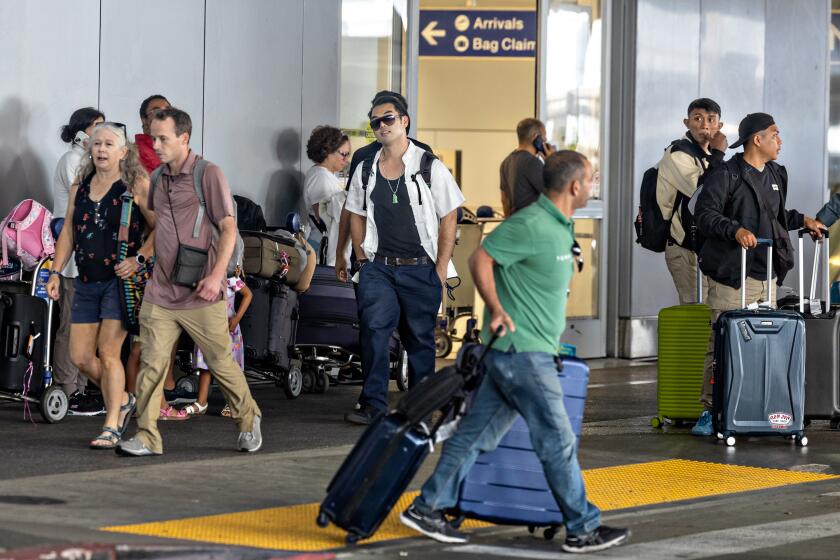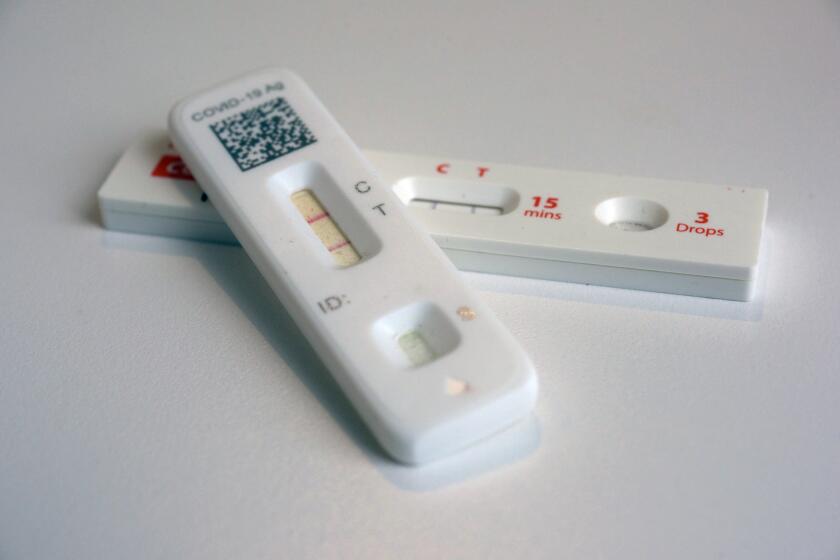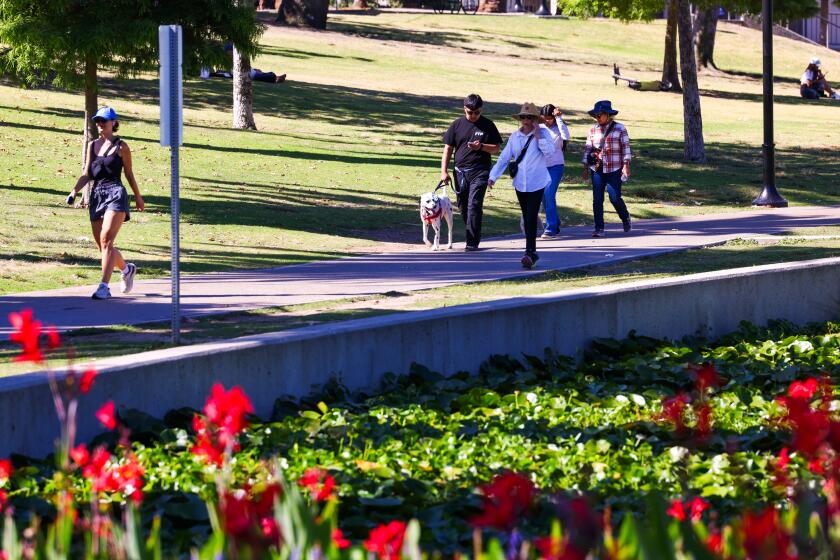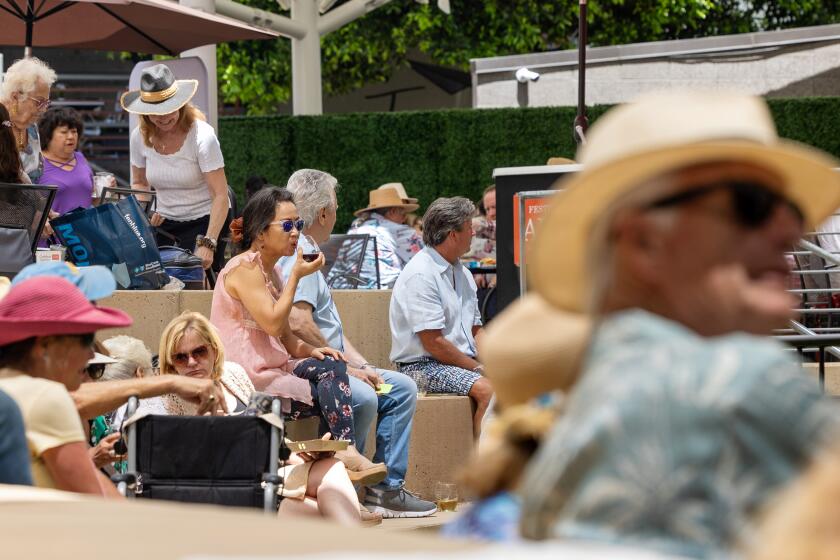California COVID surge is surprisingly stronger, longer-lasting than experts had expected

California’s summer COVID surge has proved to be particularly strong and enduring, surprising experts with its tenacity as it storms into a third month.
The strength of this summer’s COVID surge probably is largely related to the ever-more infectious subvariants that continue to emerge as the coronavirus evolves, said Dr. Elizabeth Hudson, regional chief of infectious disease at Kaiser Permanente Southern California. A dizzying number of related subvariants — collectively dubbed FLiRT — have emerged in recent months. One in particular, KP.3.1.1, has been picking up steam at a startling pace and has become the most common strain nationwide.
“KP.3.1.1 seems to be the most adept at transmission,” said Dr. Peter Chin-Hong, an infectious diseases expert at UC San Francisco. “And it’s the one that people think will continue to take over, not only in the United States, but ... around the world.”
Coronavirus levels in California wastewater have surpassed the peaks seen in each of the last two summers, according to data estimates released Friday by the U.S. Centers for Disease Control and Prevention, which run through the week ending July 27. Coronavirus levels in sewage have been “high” or “very high” for eight consecutive weeks.
“This particular surge ... is fairly robust and long-lasting, lasting a little longer than I thought that it would. It’s certainly very different from last summer,” Hudson said.
California is one of 43 states, as well as the District of Columbia, with “high” or “very high” coronavirus levels in wastewater.
While hospitalizations overall remain a fraction of those seen during earlier COVID summertime spikes, hospitalizations and emergency room visits have been ticking up, and clinics are seeing high numbers of infected patients.
“This is not a benign wave,” wrote Dr. Eric Topol, director of the Scripps Research Translational Institute in La Jolla, in a blog post published Saturday. “It’s a major wave now ... we haven’t yet reached the plateau.”
In Los Angeles County, there were an average of 389 coronavirus-positive hospitalized patients per day for the week that ended July 27, roughly twice as high as a month ago. The latest number is about two-thirds of the peak from last summer and one-third the peak from the summer of 2022.
“We are seeing a lot of outpatient cases — it’s been a much higher uptick over the last week, actually,” Hudson said Friday.
COVID cases and hospitalizations rise in L.A. County — and some of those recently reinfected with the FLiRT variants are finding the latest bout the worst yet.
For the week that ended Saturday, the CDC estimated that KP.3.1.1 comprised 27.8% of coronavirus samples nationwide, an astonishing jump from its 7.2% share a month ago.
Because the FLiRT subvariants are related, it’s likely that being infected with one will provide some protection against the others — at least for a time.
But if you’re further removed from a brush with COVID, the rise of KP.3.1.1 heightens the risk of infection, as it has evolved to be even more contagious, Chin-Hong said.
Amid this ever-more-infectious backdrop, the number of people who have never had COVID-19 — the “Novids” — is dwindling.
“The proportion of ‘Novids’ is getting smaller and smaller,” Chin-Hong said. “I’ve heard so many stories in the last few weeks of people who didn’t get any [COVID illness] until this point, now in our fifth year” since COVID emerged.
After three and a half years, I finally got COVID for the first time. I asked the experts why now.
Though the newer subvariants are more easily spread, there are, generally speaking, no indications that they are more likely to put someone in the hospital.
But some people have nevertheless expressed surprise at how awful they feel from their latest COVID-19 illness, complaining of sore throats so intense they feel as if they’re swallowing razors or broken glass, and bouts of severe coughing that leave them winded.
It may be that some people are years removed from their last infection or vaccine dose, making this summer’s sickness feel especially terrible, doctors say.
“A lot of that residual protection has waned, and then you add in a new variant that is able to outwit whatever remaining immunity folks have, and we are starting to see this uptick in cases,” Hudson said.
Particular risk factors — age, underlying health conditions and how long it has been since their last vaccine dose — all can also affect the severity of someone’s COVID illness.
If it seems like many people around you are getting COVID-19, you’re not alone. Coronavirus levels in California’s wastewater are surging to levels not seen in summertime since 2022.
It’s difficult to quantify the size of this latest surge, as many people are either testing at home or not testing at all. But cases have clearly been on the rise.
For the week that ended July 28, there were an average of 452 new cases a day in L.A. County, up from 413 the prior week. Last summer’s peak was 571. Cases are an undercount, as they only include tests conducted at medical facilities.
In L.A. County, coronavirus levels in wastewater swelled to 44% of last winter’s peak over the 10-day period that ended July 20. That’s more than double the level seen a month earlier.
Coronavirus levels in L.A. County wastewater are at 82% of last summer’s peak, which occurred in early September.
With COVID numbers in California spiking this summer, experts are warning the new FLiRT strains driving the spread could be around for some time.
In Santa Clara County, the most populous in the San Francisco Bay Area, coronavirus levels are high in all sewersheds — including San Jose and Palo Alto.
The renewed wave of infections comes as many people aren’t up-to-date on their COVID vaccinations. Everyone age 6 months and up should have gotten at least one COVID vaccination since September, health officials say, but few have done so. Of Californians age 65 and up, 37% have received at least one COVID vaccination in that time frame. The same is true for 18.7% of those age 50 to 64, and just 10.1% of the youngest adults.
On top of that, many people have abandoned COVID safety measures, and are no longer worrying about spending time in stuffy indoor settings or socializing with people who are ill. Many are not wearing masks or rigorously washing their hands.
More people are seeking emergency room care for coronavirus-related illness. For the seven-day period that ended July 28, 3.7% of all emergency room visits in L.A. County were coronavirus-related. That’s up from 2.3% a month earlier. Last summer’s peak for that metric was 5.1%.
California is in the middle of its worst summer COVID wave since 2022, with virus levels and infections surging across the state.
At UC San Francisco, COVID hospitalizations had crept higher this summer, but have been stable over the last few weeks, Chin-Hong said. That, he said, suggests COVID patients aren’t ill enough to stay for very long after being admitted or require a trip to the intensive care unit.
The CDC and other health experts have a number of recommended strategies for people looking to avoid getting COVID or any other respiratory virus, such as staying up-to-date with immunizations, staying away from sick people, washing or sanitizing your hands often; and gathering outdoors or doing what you can to keep indoor air cleaner, such as opening windows to allow in fresh air and filtering indoor air.
Additional strategies include masking and asking people to test before gathering for an event, the CDC says. The strategies are especially helpful when COVID is causing a lot of illness in a community.
With most people having stopped wearing masks routinely, Chin-Hong said it’s not a bad idea to keep one handy to put on in case, say, someone next to you on the plane starts coughing.
After two Olympics were played under COVD-19 restrictions, fans are showing up to the Paris Olympics, much to the delight of athletes and organizers.
In a statement, the L.A. County Department of Public Health said the current data do not help forecast what’s in store for the rest of the summer.
The 2022 summer wave played out over 16 weeks, during which viral levels were “high” or “very high” in California. Last summer’s wave in California lasted eight weeks.
At some point, though, the spike will crest — though when it does won’t be immediately obvious. In one possibly positive sign, the CDC on Friday said that California’s COVID epidemic status was either stable or uncertain, an improvement from last week’s estimate that COVID-19 was still growing.
But merely entering a “stable or uncertain” status doesn’t necessarily mean COVID will start trending downward. Scientists will need more weeks of data to see whether the wave has peaked or is just in a temporary lull.
In only two states did the CDC estimate that COVID-19 was likely declining: Hawaii and Nevada. Besides California, the states labeled as being on a stable or uncertain COVID trajectory were Arizona, Connecticut, Florida, Idaho, Maine and Pennsylvania. COVID-19 was estimated to be growing or likely growing in 34 states, as well as the District of Columbia. No estimates were available for seven states.
With an updated COVID vaccine likely to come next month, doctors offered varying advice about whether to wait or get the current one now to protect against the latest surge.
Hudson suggested waiting. “September is a month away now,” she said.
Chin-Hong suggested older or immunocompromised individuals — who are at the highest risk of developing severe COVID illness — should consider getting the current formulation if they are not up-to-date.
In Northern California, Chin-Hong said, demand for the existing COVID-19 vaccine has increased so much that some people are having a hard time finding it. But individual drug stores should still have the vaccine, he said.
It’s possible that people who get the current vaccine now may not have to wait that long before getting the updated vaccine this fall. The U.S. Food and Drug Administration last year allowed people to get the 2023-24 updated vaccine as soon as two months after their last dose.
If that same timeline applies for the 2024-25 vaccine, that would mean someone could get the current vaccine in August, but still be able to get the updated vaccine in October, Chin-Hong said.
More to Read
Sign up for Essential California
The most important California stories and recommendations in your inbox every morning.
You may occasionally receive promotional content from the Los Angeles Times.

















